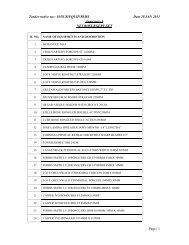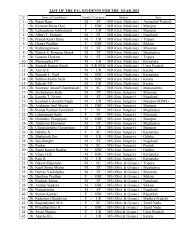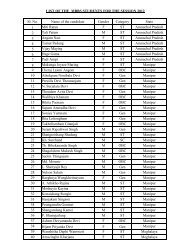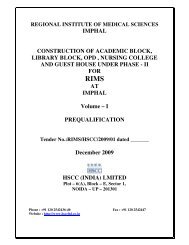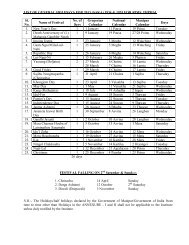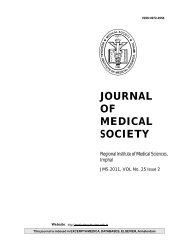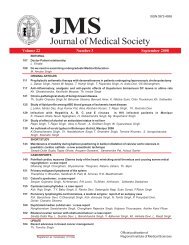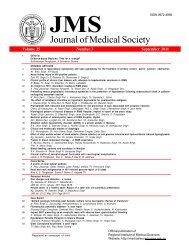Evidence-based Medicine: Time for a change? - Journal of Medical ...
Evidence-based Medicine: Time for a change? - Journal of Medical ...
Evidence-based Medicine: Time for a change? - Journal of Medical ...
You also want an ePaper? Increase the reach of your titles
YUMPU automatically turns print PDFs into web optimized ePapers that Google loves.
ORIGINAL ARTICLE<br />
as compared to bupivacaine alone, which is<br />
comparatively longer than that <strong>of</strong> the present<br />
study finding. However more sedation,<br />
<strong>change</strong> in the heart rate and mean arterial<br />
pressure were observed in their study than<br />
ours.<br />
When the analgesic effects <strong>of</strong> 150µg <strong>of</strong><br />
intrathecal clonidine were compared with<br />
placebo (saline) in cesarean section under<br />
general anesthesia, Filos KS and co-workers 3<br />
observed that clonidine provided pain relief <strong>for</strong><br />
7 +/- 2.2 hr vs. 3+/- 2.8 hr <strong>of</strong> saline. They also<br />
investigated response to 150µg, 300µg, and<br />
450µg doses <strong>of</strong> intrathecal clonidine in a<br />
similar design and patient population and<br />
observed that clonidine produced dosedependent<br />
and long-lasting analgesia (7 +/-<br />
1.3, 10 +/- 1.3, and 14 +/-1.3 hr respectively).<br />
In both the studies, they found sedation was<br />
dose dependent and more pronounced after<br />
450 µg <strong>of</strong> intrathecal clonidine. The maximum<br />
dose used in our study was 65 ìg and this low<br />
dose <strong>of</strong> clonidine (1 µg/kg) might be cause<br />
<strong>for</strong> single incidence <strong>of</strong> sedation in this series.<br />
Our study also shows that moderate<br />
prolongation <strong>of</strong> duration <strong>of</strong> analgesia is<br />
possible with low dose clonidine without<br />
sedation.<br />
Many previous studies had used intrathecal<br />
clonidine combined with opioids and local<br />
anaesthetics <strong>for</strong> labour analgesia and<br />
orthopaedic surgery. However, the<br />
combination with opioids would seem less<br />
attractive <strong>for</strong> obvious reasons. Using<br />
intrathecal clonidine in place <strong>of</strong> opioids avoids<br />
problems <strong>of</strong> respiratory depression, pruritus,<br />
urinary retention and abuse liability.<br />
The works <strong>of</strong> Dobrydnjov I et al 1 , Filos KS et<br />
al 5 , Kock DM et al 9 , where clonidine was used<br />
more than 75 ìg, found prolongation <strong>of</strong><br />
analgesia but at the expense <strong>of</strong> sedation. Even<br />
though sedation is a well known side effect <strong>of</strong><br />
clonidine we had encountered only one case<br />
in our study <strong>of</strong> intrathecal clonidine (1 µg/kg).<br />
This might be because <strong>of</strong> low dose as<br />
suggested by Eisenach et al 10 which stated<br />
that clonidine produces dose dependent<br />
sedation <strong>of</strong> rapid onset at the range 50-900<br />
ìg, regardless <strong>of</strong> route <strong>of</strong> administration. Our<br />
findings were in agreement with Kaabachi O<br />
et al 7 which again underlines the safety <strong>of</strong> low<br />
dose intrathecal clonidine.<br />
Conclusion: It might be concluded that<br />
intrathecal clonidine at the dose <strong>of</strong> 1µg/kg<br />
significantly prolongs the post-operative pain<br />
free period without significant cardiovascular<br />
<strong>change</strong>s and side effects.<br />
Reference<br />
1. Dobrydnjov I, Axelsson K, Samartel J,<br />
Holmstrom B. Postoperative pain relief<br />
following intrathecal bupivacaine<br />
combined with intrathecal or oral clonidine.<br />
Acta Anaesthesiol Scand 2002; 46:806-<br />
14.<br />
2. Chiari A, Lober C, Eisenach JC, Wildling<br />
E, Krenn C, Zavrsky A et al. Analgesic and<br />
hemodynamic effects <strong>of</strong> intrathecal<br />
clonidine as the sole analgesic agent<br />
during first stage <strong>of</strong> labor:A doseresponse<br />
study. Anesthesiology1999;<br />
9:388-96.<br />
3. Filos KS, Goudas LC, Patroni O, Polyzou<br />
V. Intrathecal clonidine as a sole analgesic<br />
<strong>for</strong> pain relief after cesarean section.<br />
Anesthesiology 1992; 77:267-74.<br />
4. Benhamou D, Thorin D, Brichant JF,<br />
Dailland P, Milon D, Schneider M.<br />
Intrathecal clonidine and fentanyl with<br />
hyperbaric bupivacaine improve analgesia<br />
during cesarean section . Anesth Analg<br />
1998; 87: 609–13.<br />
5. Filos KS, Goudas LC, Patroni O, Polyzou<br />
V. Hemodynamic and analgesic pr<strong>of</strong>ile<br />
after intrathecal clonidine in humans. A<br />
dose-response study. Anesthesiology<br />
1994; 81:591-601.<br />
6. Owens WD, Felts JA, Spitznagel EL Jr.<br />
ASA physical Status classification: a study<br />
<strong>of</strong> consistency <strong>of</strong> ratings. Anesthesiology<br />
1978; 49:239-43.<br />
7. Kaabachi O, Zarghouni A, Ouezini R,<br />
Abdelaziz AB, Chattaoui O,Kokki H.<br />
Clonidine 1 µg/kg is a safe and effective<br />
32 JMS * JMS Vol 25 * Vol * No. 25 3 * No. * September, 1 * June, 2010 2011



